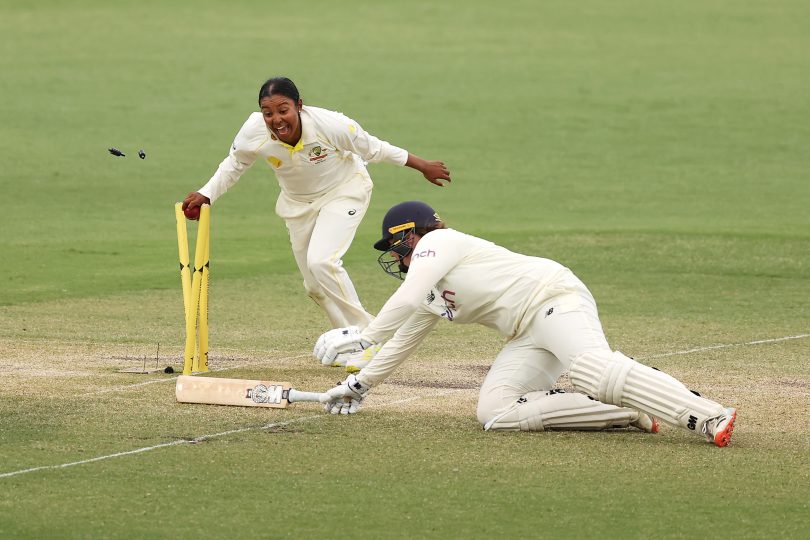
The Australian team take the field during day two of the Women’s Test match in the Ashes series between Australia and England at Manuka Oval. Photo: Mark Kolbe/Getty Images.
A decade ago there was hardly any women’s sport on free-to-air or pay television. The only offering was the Olympics and Commonwealth Games, one game a weekend of the WNBL and the W League, the Australian Open Golf and tennis.
For a number of these sports, there was a sense that broadcasters begrudgingly provided coverage of women’s sport as they feared a ratings drop-off.
It becomes a self-fulfilling prophecy that if there is no genuine long-term commitment to covering the sport, it stands to reason that viewers have no real affinity with the product and it won’t rate.
I remember being involved in various think tanks on how to increase the coverage of women’s sport, which in turn leads to greater participation in sport among women with the phrase ‘you can’t be what you can’t see’ used to great effect.
The benefits of increased exposure are obvious, including greater revenue coming into the sport providing sportswomen with the ability to go full time in parity with their male counterparts.
There has been somewhat of a revolution since March 2020 when 825,000 viewers tuned in to Nine’s Gem to watch the Australian women’s cricket team win the World Cup.
It put women’s cricket well and truly into the spotlight, proving that viewership would follow if women’s sports events were covered with the same resourcing as the men’s competitions.
Last weekend proves further proof of this. Seven of the top 10 programs on Foxtel on Sunday related to the Women’s Ashes Test at Manuka Oval. There was also free-to-air coverage on Channel 7.

Alana King of Australia runs out Anya Shrubsole of England during day four of the Women’s Test match in the Ashes series between Australia and England at Manuka Oval. Photo: Mark Kolbe/Getty Images.
The night before the Ashes coverage, Ash Barty’s victory over American Danielle Collins averaged 3.577 million viewers, with a peak of 4.261 million.
In comparison, the average number of viewers for last year’s AFL men’s Grand Final was 4.11 million.
According to a report in The Sydney Morning Herald, viewer figures for the women’s test on Sunday stood at 440,000 on free-to-air, with many more watching on streaming services such as Foxtel and Kayo.
Prior to this, Channel 7’s excellent coverage of the Tokyo Olympics, where nine of the top 20 programs involved women’s sports, proved that viewers were there if women’s sport was televised.
Super Netball has established itself as the major women’s sport on television in winter, while the Super W rugby union and NRL women’s competitions are yet to fully establish a footing.
Over the past couple of weekends, women’s sports has been on every free-to-air television network with cycling, WNBL, A-League Women’s, AFLW, cricket and Women’s Asian Cup Football featuring.
The ability to provide coverage on multiple free-to-air channels has been a significant driver. Pay television coverage has complemented this and enhanced the product on free-to-air on many occasions.
One issue that does stand in the way is the lack of women’s sports events available to television networks to televise.
The majority of premier women’s sporting competitions in Australia take place over summer, including AFLW, the WNBL, A-League Women and women’s cricket, so there is plenty of momentum at the moment for women’s sport on free-to-air television in particular.
This makes Channel 9’s decision to relinquish the rights to the Women’s Cricket World Cup to be staged in New Zealand this year somewhat surprising.
The result of Channel 9’s decision is that it won’t be available for free-to-air viewers but will be available to Foxtel and Kayo subscribers.
This decision signals that there is still some way to go, but there is a sense of a tidal wave with demand for more coverage of women’s sport greater than ever.
Original Article published by Tim Gavel on Riotact.









